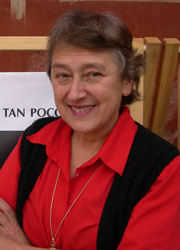 |
 |
|
 |
 |
 |
 |
 |
|
 |
 |
 |
 |

Director's Seminar
 |
|
Lynn Margulis
Photo credit: Luis Rico
|
|
08/07/07 - 4:00 PM - Lillie Auditorium
"Origin of the Mitotic Nucleus: Symbiogenesis in the Sulfurous Proterozoic Eon" - Lynn Margulis, University of Massachusetts, Amherst - 4:00 PM, Lillie Auditorium
Abstract:
We (Michael Chapman, Michael Dolan, John Hall, Dennis Searcy; University of Massachusetts-Amherst) present the sulfur syntrophic/karyomastigont model of the origin of the nucleus-cytoskelton system. We have few "missing links" in our posited scenario of acquisition and genomic integration of microbial symbionts. Symbiogenesis, a major mode of evolutionary innovation, generated the last eukaryotic common ancestor (LECA ) whereas the accumulation of random mutations played a minor, modulating-only role. Eukaryosis, origin of nucleated cells, resulted from an identifiable microbial merger: a wall-less archaebacterium (Thermoplasma acidophila-like) and a eubacterium (Spirochaeta , Dubinina's Perfiel'va ) fused in anoxic or microxic sulfide-rich environments in which selection pressure led to rapidly motile amitochondriate protist heterotrophs.
No substitute for direct study of microbes in nature exists. We have video-documented bacteria and protists interpretable as modern analogues in the evolutionary scenario for the first nucleated cells. Descendants of these swimming anaerobic eukaryotes today thrive in organic-rich habitats where they are amenable to study. Eukaryosis occurred by the middle Proterozoic Eon prior to the deposition in sediments of certain well-preserved microfossils such as Vandalsphaeridium (Vidal, 1998) and spiny spheres in Doushantou cherts of China (Knoll, 2003).
Our scheme that generates new observations and experiments is based on observations by Lemuel R. Cleveland (1892-1971; Harvard University), Harold Kirby, Jr. (1900-1952; University of California at Berkeley) and Edouard Chatton (1880-1947; Laboratoire Arago, Banuyls-sur-mer, France). Cleveland’s detailed work on cell motility, i.e., movements of undulipodia, the mitotic spindle and, “attraction spheres” (centriole-like organelles), Kirby on parabasalids and their associated bacteria and Chatton's inclusive taxa based on mitotic variation complement new data (2007). Taken together the Alliegro's studies of centrosome-centriolar nucleic acids, genomic analysis by John L. Hall of spirochete contributions to the eukaryotic lineage and by Jacques Meyer (Grenoble) on evolution of hydrogenases all bolster our hypothesis.
Lynn Margulis, Distinguished University Professor in the Department of Geosciences at the University of Massachusetts-Amherst, was elected to the National Academy of Sciences in 1983. She received from William J. Clinton the National Medal of Science in 1999. The Library of Congress, Washington, DC, announced in 1998 that it will permanently archive her papers. Lynn served as president of Sigma Xi from 2005-2006. She received the Proctor Prize for scientific achievement in 1999 from this society. Prior to her move to the Botany Department at the University of Massachusetts she was a faculty member at Boston University for 22 years.
Her publications span a wide-range of scientific topics. They include original contributions to cell biology and microbial evolution. She probably is best known for contributions to the theory of symbiogenesis. She challenges a central tenet of neoDarwinism when she argues that significant inherited variation does not come mainly from random mutation. Rather, new tissues, organs, and even new species evolve primarily through the long-lasting intimacy of strangers. The fusion of genomes in symbioses followed by natural selection, she posits, leads to increasingly complex levels of individuality. Beyond contributions to evolution, Dr. Margulis is acknowledged for her work with James E. Lovelock on his Gaia concept. Gaia theory posits that the Earth’s surface interactions among living beings in sediment, air, and water have created a vast self-regulating system.
Professor Margulis, who participates in hands-on teaching activities at levels from middle to graduate school, is the author of many articles and books. Recent publications include Symbiotic Planet: A New Look at Evolution (1998), Acquiring Genomes: A Theory of the Origins of Species (2002), co-written with Dorion Sagan, explains how symbiosis works in evolution and Luminous Fish: Tales of Science and Love (2006). Indeed, over the past decade and a half, Professor Margulis has co-written a number of books with Sagan, among them What is Sex? (1997), What is Life? (1995), Mystery Dance: On the Evolution of Human Sexuality (1991), Microcosmos: Four Billion Years of Evolution from Our Microbial Ancestors (1986), and Origins of Sex: Three Billion Years of Genetic Recombination (1986). Her work with K. V. Schwartz (1998) provides a consistent, formal, illustrated classification of all life (phyla) on Earth, and is in progress with the 4th edition. It is based on international work and encompasses life's immense diversity from microbes to reef-building corals. The logical basis for it is summarized in her single-authored book Symbiosis in Cell Evolution: Microbial Communities in the Archean and Proterozoic Eons (second edition, 1993). The bacterial origins of both chloroplasts and mitochondria are established. She works now with a few close colleagues on the origin of cilia from spirochetes.
|
| |
  |
|
 |
 |
|